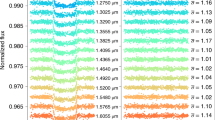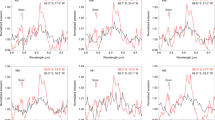Abstract
Water is predicted to be among the most abundant (if not the most abundant) molecular species after hydrogen in the atmospheres of close-in extrasolar giant planets (‘hot Jupiters’)1,2. Several attempts have been made to detect water on such planets, but have either failed to find compelling evidence for it3,4 or led to claims that should be taken with caution5. Here we report an analysis of recent observations of the hot Jupiter HD 189733b (ref. 6) taken during the transit, when the planet passed in front of its parent star. We find that absorption by water vapour is the most likely cause of the wavelength-dependent variations in the effective radius of the planet at the infrared wavelengths 3.6 μm, 5.8 μm (both ref. 7) and 8 μm (ref. 8). The larger effective radius observed at visible wavelengths9 may arise from either stellar variability or the presence of clouds/hazes. We explain the report of a non-detection of water on HD 189733b (ref. 4) as being a consequence of the nearly isothermal vertical profile of the planet’s atmosphere.
This is a preview of subscription content, access via your institution
Access options
Subscribe to this journal
Receive 51 print issues and online access
$199.00 per year
only $3.90 per issue
Buy this article
- Purchase on Springer Link
- Instant access to full article PDF
Prices may be subject to local taxes which are calculated during checkout



Similar content being viewed by others
References
Seager, S. & Sasselov, D. D. Theoretical transmission spectra during extrasolar giant planet transits. Astrophys. J. 537, L916–L921 (2000)
Liang, M. C., Parkinson, C. D., Lee, A. Y.-T., Yung, Y. L. & Seager, S. Source of atomic hydrogen in the atmosphere of HD209458b. Astrophys. J. 596, L247–L250 (2003)
Richardson, L. J., Deming, D., Horning, K., Seager, S. & Harrington, J. A spectrum of an extrasolar planet. Nature 445, 892–895 (2007)
Grillmair, C. J. et al. A Spitzer spectrum of the exoplanet HD189733b. Astrophys. J. 658, L115–L118 (2007)
Barman, T. Identification of absorption features in an extrasolar planet atmosphere. Astrophys. J. 661, L191–L194 (2007)
Bouchy, F. et al. ELODIE metallicity-biased search for transiting hot Jupiters II. A very hot Jupiter transiting the bright K star HD189733. Astron. Astrophys. 444, L15–L19 (2005)
Beaulieu, J. P. et al. Spitzer observations of the primary transit of the planet HD189733b at 3.6 and 5.8 μm. Astrophys. J. (submitted)
Knutson, H. A. et al. A map of the day-night contrast of the extrasolar planet HD 189733b. Nature 447, 183–186 (2007)
Winn, J. N. et al. The transit light curve project. V. System parameters and stellar rotation period of HD 189733. Astron. J. 133, 1828–1835 (2007)
Brown, T. M. Transmission spectra as diagnostics of extrasolar giant planet atmospheres. Astrophys. J. 553, 1006–1026 (2001)
Tinetti, G. et al. Infrared transmission spectra for extrasolar giant planets. Astrophys. J. 654, L99–L102 (2007)
Charbonneau, D., Brown, T. M., Noyes, R. W. & Gilliland, R. L. Detection of an extrasolar planet atmosphere. Astrophys. J. 568, 377–384 (2002)
Vidal-Madjar, A. et al. An extended upper atmosphere around the extrasolar planet HD209458b. Nature 422, 143–146 (2003)
Vidal-Madjar, A. et al. Detection of oxygen and carbon in the upper atmosphere of the extrasolar planet HD209458b. Astrophys. J. 604, L69–L72 (2004)
Ballester, G. E., Sing, D. K. & Herbert, F. The signature of hot hydrogen in the atmosphere of the extrasolar planet HD 209458b. Nature 445, 511–514 (2007)
Knutson, H. A., Charbonneau, D., Noyes, R. W., Brown, T. M. & Gilliland, R. L. Using stellar limb-darkening to refine the properties of HD 209458b. Astrophys. J. 655, 564–575 (2007)
Barber, R. J., Tennyson, J., Harris, G. J. & Tolchenov, R. A high accuracy computed water line list. Mon. Not. R. Astron. Soc. 368, 1087–1094 (2006)
Burrows, A., Sudarsky, D. & Hubeny, I. Theory for the secondary eclipse fluxes, spectra, atmospheres and light curves of transiting extrasolar giant planets. Astrophys. J. 650, 1140–1149 (2006)
Liang, M. C., Yung, Y. L. & Shemansky, D. E. Photolytically generated aerosols in the mesosphere and thermosphere of Titan. Astrophys. J. 661, L199–L201 (2007)
Rothman, L. S. et al. The HITRAN 2004 molecular spectroscopic database. J. Quant. Spectrosc. Radiat. Transf. 96, 139–204 (2005)
Allard, N. F., Allard, F., Hauschildt, P. H., Kielkopf, J. F. & Machin, L. A new model for brown dwarf spectra including accurate unified line shape theory for the Na I and K I resonance line profiles. Astron. Astrophys. 411, L473–L476 (2003)
Allard, N. F., Spiegelman, F. & Kielkopf, J. F. Study of the K-H2 quasi molecular line satellite in the potassium resonance line. Astron. Astrophys. 465, 1085–1091 (2007)
Borysow, A., Jorgensen, U. G. & Fu, Y. High temperature (1000–7000K) collision induced absorption of H2 pairs computed from the first principles, with application to cool and dense stellar atmospheres. J. Quant. Spectrosc. Radiat. Transf. 68, 235–255 (2001)
Goody, R. M. & Yung, Y. L. Atmospheric Radiation (Oxford Univ. Press, New York, 1989)
Richardson, L. J., Harrington, J., Seager, S. & Deming, D. A Spitzer infrared radius for the transiting extrasolar planet HD209458b. Astrophys. J. 649, 1043–1047 (2006)
Charbonneau, D. et al. Detection of thermal emission from an extrasolar planet. Astrophys. J. 626, 523–529 (2005)
Deming, D., Seager, S., Richardson, L. J. & Harrington, J. Infrared radiation from an extrasolar planet. Nature 434, 740–743 (2005)
Fortney, J. J., Cooper, C. S., Showman, A. P., Marley, M. S. & Freedman, R. S. The influence of atmospheric dynamics on the infrared spectra and light curves of hot Jupiters. Astrophys. J. 652, 746–757 (2006)
Hanel, R. A. et al. The Nimbus 4 infrared spectroscopy experiment 1. Calibrated thermal emission spectra. J. Geophys. Res. 77, 2629–2639 (1972)
Fortney, J. J. & Marley, M. S. Analysis of Spitzer mid infrared spectra of irradiated planets: Evidence for water vapor? Astrophys. J. (submitted)
Acknowledgements
We thank A. Lecavelier, D. Ehrenreich, J.-M. Désert, Roger Ferlet and G. Hebrard for their work on the IRAC observations. We thank A. Noriega-Crespo and the Spitzer Staff for helping to schedule the observations with IRAC, and E. Lellouch, A. Morbidelli, B. Schultz, F. Bouchy and J. B. Marquette for useful input to the paper. M.-C.L. and Y.Y. were supported by NASA and the Virtual Planetary Laboratory at the California Institute of Technology.
Author information
Authors and Affiliations
Corresponding author
Ethics declarations
Competing interests
Reprints and permissions information is available at www.nature.com/reprints. The authors declare no competing financial interests.
Rights and permissions
About this article
Cite this article
Tinetti, G., Vidal-Madjar, A., Liang, MC. et al. Water vapour in the atmosphere of a transiting extrasolar planet. Nature 448, 169–171 (2007). https://doi.org/10.1038/nature06002
Received:
Accepted:
Issue Date:
DOI: https://doi.org/10.1038/nature06002
This article is cited by
-
ExoSim: the Exoplanet Observation Simulator
Experimental Astronomy (2021)
-
From bridges to cycles in spectroscopic networks
Scientific Reports (2020)
-
ArielRad: the Ariel radiometric model
Experimental Astronomy (2020)
-
Possible Atmospheric Diversity of Low Mass Exoplanets – Some Central Aspects
Space Science Reviews (2020)
-
Outstanding Challenges of Exoplanet Atmospheric Retrievals
Space Science Reviews (2020)
Comments
By submitting a comment you agree to abide by our Terms and Community Guidelines. If you find something abusive or that does not comply with our terms or guidelines please flag it as inappropriate.



